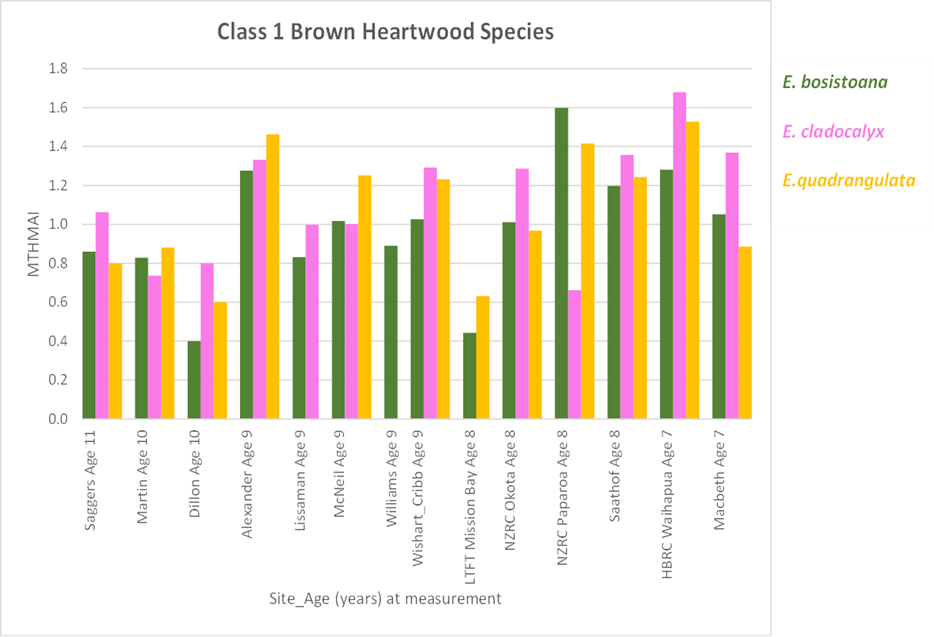Phone: 03 577 2395
C/- Marlborough Research Centre Trust, PO Box 875, Blenheim 7201


The three Class 1 brown heartwood species being evaluated in NZDFI's demonstration trials are:
Comparative growth of the three species

Class 1 brown heartwood species comparaive growth (Mean Top Height Mean Annual Increment - MTHMAI) across all sites.
E. bosistoana - Coast grey box
E. bosistoana is a principal species in the NZDFI breeding programme. It produces class 1 durable hardwood and should grow well in a range of New Zealand conditions.
The trials results show that E. bosistaona establishes well. The overall avaerage MTHMAI is 1.0m, but productivity varies markedly between sites.
It is exhibiting high productivity on Hawkes Bay sites with limestone derived soils and sites with higher rainfall, and moderate productivity on a variety of other sites. It has survived and thrived on wet sites with both light and heavy soils. It has also survived repeated flood events on well-drained soils. It has exhibited lower productivity on drier exposed sites.
The species does show extremely variable stem form and branching habit; this is being addressed in our breeding programme.
It is susceptible to browsing insect pests (e.g. eucalypt tortoise beetle and eucalypt variegated beetle).
For more information about E. bosistoana see:
-----------------------------------
E. cladocalyx - Sugar gum
E. cladocalyx is a class 1 species included in NZDFI trials because it grows well and is highly regarded in dry Australian climates.
The trial results show an overall average MTHMAI of 1.1m, but with a high degree of variability between sites. It has proven to be one of the most frost-sensitive species deployed in NZDFI trials.
Where it has established successfully it has grown well, especially on drier sites with limestone or sedimentary-derived soils. The best MTHMAI (1.7m) is at the Hawkes Bay Regional Council Waihapua site.
E. cladocalyx has performed poorly on higher rainfall sites and poorly drained soils.
It has proved resistant to insect browse and disease.
For more information about E. cladocalyx, see:
-----------------------------------
E. quadrangulata - White-topped box
E. quadrangulata is a secondary species in NZDFI's breeding programme. It produces Class 1-2 durable timber, and is expected to thrive across a wide range of site types.
The trial results have proven this site adaptability, with good estabhlishment and early growth. There is high variability between the best and worst sites.
The highest productivity (1.5m MTHMAI) is at the Hawkes Bay Regional Council Waihapua site; it has shown moderate productivity on a range of other sites especially with higher rainfall, and low productivity where there is poor drainage or dry, exposed conditions.
It is susceptible to insect pest browsing, but appears to recover well.
For more information about E. quadrangulata, see:
C/- Marlborough Research Centre Trust, PO Box 875, Blenheim 7201